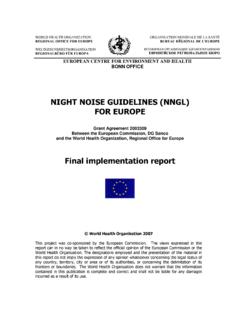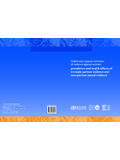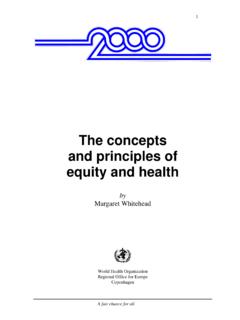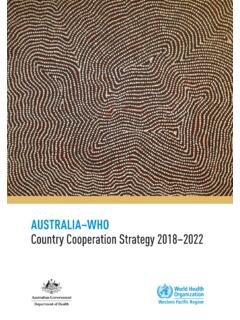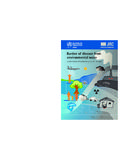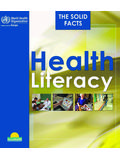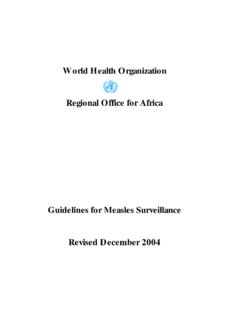Transcription of WORLD HEALTH ORGANIZATION ORGANISATION …
1 WORLD HEALTH ORGANIZATION regional OFFICE FOR EUROPE WELTGESUNDHEITSORGANISATION REGIONALB RO F R EUROPA ORGANISATION mondiale DE LA SANT BUREAU R GIONAL DE L'EUROPEВСЕМИРНАЯ ОРГАНИЗАЦИЯ ЗДРАВООХРАНЕНИЯЕВРОПЕЙСКОЕ РЕГИОНАЛЬНОЕ БЮРО Workshop English only Early Warning Function under the framework of the International HEALTH Regulations (IHR) Copenhagen, 16 to 18 June 2008 4 April 2008 PROVISIONAL SCOPE AND PURPOSE Background The current International HEALTH Regulations (IHR) were adopted by the WHO Member States during the 58th WORLD HEALTH Assembly in 2005 and entered into force on 15 June 2007 (Resolution ). The IHR aim to prevent, protect against, control and provide a public HEALTH response to the international spread of disease in ways that are commensurate with and restricted to public HEALTH risks, and which avoid unnecessary interference with international traffic and trade (IHR Article 2).
2 Their scope includes HEALTH events and public HEALTH risks of infectious, chemical, radio-nuclear and unknown origin. The IHR describe obligations, rights and procedures for both States Parties and WHO. The IHR are legally binding and compatibility of national legislation is a prerequisite for successful implementation. Benefits of IHR implementation include strengthened national and international public HEALTH security, image and public trust, while the Regulations strive to reduce the risk of unilateral traffic and trade restrictions. Each State Party is required to designate a National IHR Focal Point (NFP) and authorities responsible within its respective jurisdiction for the implementation of the IHR (IHR Article 4). The NFP shall disseminate information to and consolidate input from relevant sectors and should be accessible at all times for communication with the WHO IHR Contact Point.
3 Further to the above, in order to detect, assess (as per instrument in IHR Annex 2), notify, report, verify and respond to events of potential international public HEALTH concern, States Parties are required to maintain a set of core capacities with regard to surveillance and response (IHR Annex 1). The public HEALTH Early Warning Function is a key component of the core capacities with regard to surveillance and response. By 14 June 2009, each State Party shall assess national structures and resources as for their ability to meet the minimum core capacity requirements and develop a national action plan. The national action plan shall be implemented to ensure that the core capacities are present and functioning throughout the State Party s territory by 14 June 2012.
4 The IHR implementation process poses a challenge to States Parties, notably due to the broad scope of the IHR, the all-hazards and multisectoral approach and the related assessment, planning and resource mobilization for strengthening of capacities. The WHO regional Office for Europe, in compliance with its obligations (IHR Annex 1A, Paragraph 3), seeks to assist States Parties in the European Region in their efforts to implement the IHR. Accordingly, meetings for NFPs are organized on an annual basis. This year, since the public HEALTH Early Warning Function is fundamental in the IHR context, assessment and planning exercises with regard to this function will be incorporated in the meeting for representatives from the eastern part of the WHO European Region.
5 General objective To facilitate the implementation of the IHR in States Parties in the eastern part of the WHO European Region Specific objectives To provide a platform for reviewing status and exchanging experiences among States Parties and WHO with regard to IHR implementation and the public HEALTH Early Warning Function To initiate/advance the IHR-related assessment and planning process with regard to the public HEALTH Early Warning Function To initiate/advance the process of compiling an inventory of formal and informal information or data sources that should support the public HEALTH Early Warning Function To initiate/advance a gap analysis with regard to the public HEALTH Early Warning Function To initiate/advance the process of developing an organigramme, reflecting the information flow and division of tasks between the NFP and national stakeholders with regard to the public HEALTH Early Warning Function Expected results At the end of the training, the participants will be able to engage and coordinate national stakeholders to.
6 Develop an inventory of formal and informal information or data sources that should support the public HEALTH Early Warning Function Conduct a gap analysis with regard to the public HEALTH Early Warning Function Develop an organigramme, reflecting the information flow and division of tasks between the NFP and national stakeholders with regard to the public HEALTH Early Warning Function Incorporate the outcome of the above exercises in the IHR national action plan by 14 June 2009, including a strategy to mobilize human and financial resources General programme The IHR will be introduced to ensure that the whole audience is aware of the context of the meeting. An update regarding the IHR implementation in the Region as well as globally will be provided.
7 Concepts related to the public HEALTH Early Warning Function will be presented, with a particular emphasis on all-hazards event-based and indicator-based surveillance and integration of surveillance functions. Approaches to engage clinicians and the community will be presented. Invited speakers will play a central role during the workshop by illustrating features of the public HEALTH Early Warning Function, through examples of events and approaches in different countries. Discussion and reflection based on these examples is anticipated to constitute a primary added value of the workshop. Participants will during a country-specific assessment/planning activity be given the opportunity to initiate/advance the corresponding process with regard to the public HEALTH Early Warning Function, aided by present experts.
8 Upon return to their home countries, the participants will be expected to engage additional national stakeholders to complete the assessment and planning exercises in order to finalize the concrete outcomes mentioned under Expected results . Participants Total: 40 participants Target audience: National IHR Focal Points (NFP) and state epidemiologists (or equivalent) from States Parties in the eastern part of the WHO European Region, , Albania, Armenia, Azerbaijan, Belarus, Bosnia and Herzegovina, Croatia, Georgia, Kazakhstan, Kyrgyzstan, Moldova, Montenegro, Russian Federation, Serbia, Tajikistan, The former Yugoslav Republic of Macedonia, Turkey, Turkmenistan, Ukraine, Uzbekistan Workshop arrangements Venue: Pharmakon, Hiller d, Denmark Duration: 3 days Dates: 16 to 18 June 2008 Simultaneous translation between English and Russian will be provided Resource persons Technical contact persons.
9 Dr Roberta Andraghetti, WHO regional Office for Europe, Copenhagen Dr Josh Mott, Centers for Disease Control and Prevention, Atlanta Dr Marten Kivi, WHO regional Office for Europe, Copenhagen Administrative contact persons: Annalisa Corsi, WHO regional Office for Europe, Copenhagen 1 EPISOUTHC ross-Border & Epidemic Intelligencein Mediterranean CountriesPhilippe BARBOZA, Fatima A T-BELGHITIfor the EpiSouth WP6 steering teamDepartment of International and Tropical Diseases Institut de Veille Sanitaire (InVS), France BackgroundMediterranean countries : Share same : history, populations, epidemiological blockObjective : Create a framework on epidemiological issues to improve across the countries of the Mediterranean and BalkansCommunicable diseases surveillance, Communication and training StructureFramework WPsWP1:Coordination (ISS), ItalyWP2:Dissemination (ISS), ItalyWP3:Evaluation, Veneto Region, ItalyHorizontal WPsWP4:Network (Veneto Region), Italy WP5:Training (ISCIII) SpainVertical WPsWP6:Epidemic intelligence (InVS) FranceWP7:VPD & Migrants (NICPD) BulgariaWP8:Emerging zoonoses (HCDCP) GreeceCountries : Active participationto project construction through their involvement in WP Steering : Initial 3 Years periodStart : December 2006 (in practice April 2007)Funding.
10 European Commission + Italian MoHThe Challenge Geographical coverage 4 geographical / political areas Number of countries (N=27)Number of Institutional partners WHO-EURO, WHO-EMRO, WHO-HQ (WHO-AFRO)ECDC All countries expressed genuine interest and willingness to contributeProject under construction and in constant evolutionInput needed from all partners Countries Institutional partners 10 Establish a common platform on epidemic intelligence where participating countries may find broad internationally as well as regionally focused information. Two components : Monitoring of HEALTH events of international importance (Epidemic Intelligence) regional Cross Border issuesWP6 :Cross-border & Epidemic IntelligenceTwo strategic axesRestrictedTo EpiSouth partnersOpen &RestrictedSupportSupportOnly OfficialFrom EpiSouth partnersOfficial &InformalSourceSourceWithinEpiSouthcount riesOutside EpiSouth areasScopeScopeCross BorderInternational Epidemic Intelligence 12 International Epidemic IntelligenceProcessAs previously described for France EIIdentification of primary signals Formal & informal sources Selection of relevant signals EpiSouth criteriaValidation AnalysisCommunicationTailoredto EpiSouth needsElaboration with WP6 Steering Team Example Weekly Bulletin Short Brief presentation of the situation AnalysisPerspective Short updates only if significant changesFollow up of major crisis Avian influenza
